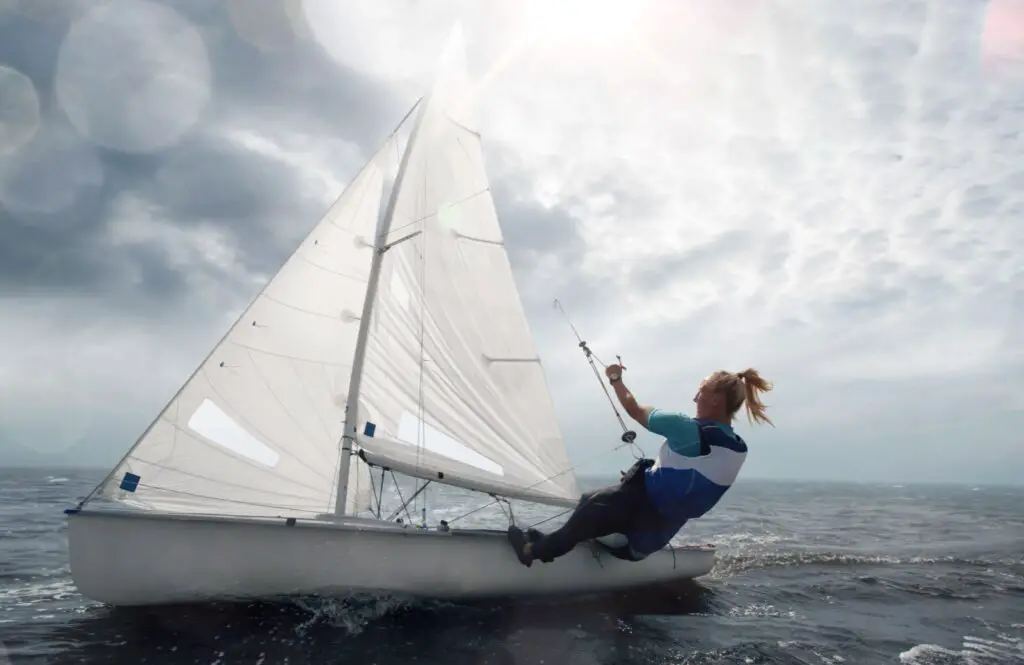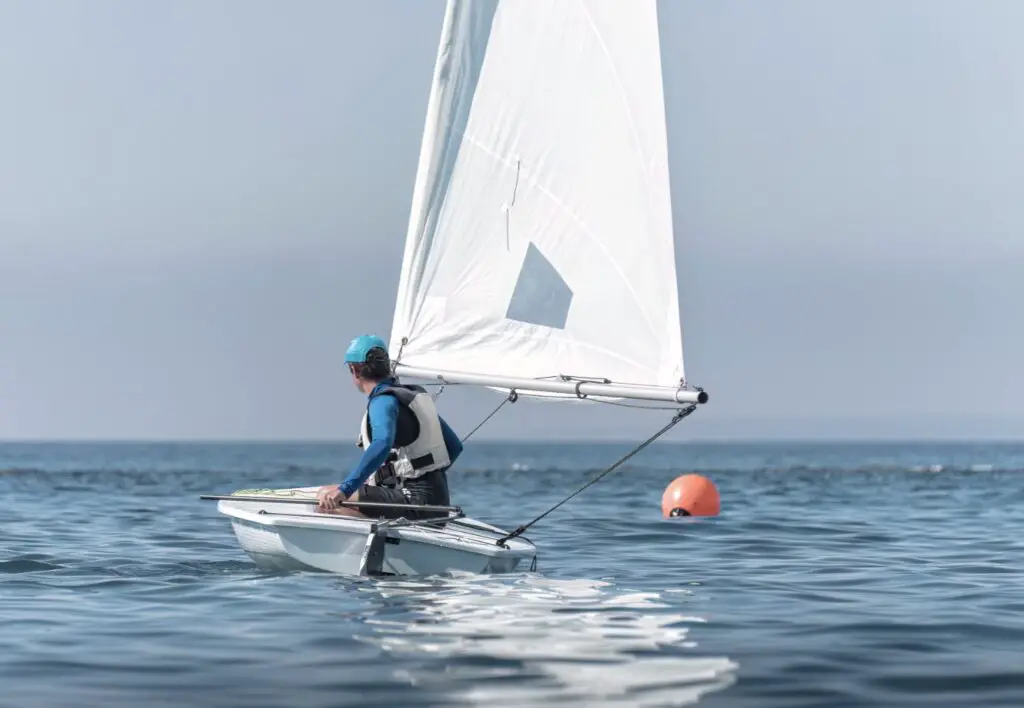Sailing has long been associated with freedom, adventure, and timeless exploration. For me, it is one of my favorite sports.
The more I have sailed, the more I notice that sailing is also surrounded by myths that make it seem intimidating or exclusive, keeping many potential enthusiasts away from experiencing the joys of the open water. Read on as we will debunk seven common sailing myths and misconceptions, showing that sailing is more accessible, inclusive, and rewarding than you might think.
Table of Contents
- Setting Sail: Debunking the Top 7 Myths and Misconceptions About Sailing
- 1. “You Need to Be Rich to Sail”
- 2. “Only Young People Can Start Sailing”
- 3. “You Have to Be an Expert Swimmer”
- 4. “Sailing Is Too Difficult to Learn”
- 5. “Sailing is Dangerous”
- 6. “Sailing Requires Lots of Physical Strength”
- 7. “You Need to Live Near the Coast”
- Listen To Our Podcast About What Are the Top 7 Myths About Sailing and Why Aren’t They True? Below or By clicking here.
- Related Questions
Setting Sail: Debunking the Top 7 Myths and Misconceptions About Sailing
Sailing is a sport surrounded by many misconceptions, from the belief that you must be incredibly wealthy to participate to the idea that only certain ages are suitable for learning. In reality, these are just myths. Join us as we debunk seven of the most common misconceptions about sailing.

1. “You Need to Be Rich to Sail”
This is perhaps the most pervasive myth about sailing and couldn’t be further from the truth. While images of luxury yachts and regattas may dominate media portrayals, sailing is not exclusively for the wealthy.
Many affordable options make sailing accessible to people from all walks of life.
Affordable Sailing Options:
- Community Sailing Centers: Places like the Milwaukee Community Sailing Center provide low-cost memberships, lessons, and boat access. You can learn to sail and enjoy regular time on the water for a fraction of the cost of owning a boat. Many other cities have similar facilities, making sailing more inclusive and community-oriented.
- Crew Opportunities: Many sailing clubs and private boat owners look for crew members to help on their boats. Often, you can learn on the job without needing to own a boat yourself.
- Buying Used Boats: If you’re set on owning your boat, the market for second-hand boats offers numerous affordable options. Many used sailboats are priced comparably to a used car, and the owner can often do ongoing maintenance to save money.
Sailing is as much about community and resourcefulness as it is about having access to a boat. Don’t let the myth of exclusivity stop you from pursuing your nautical dreams.
2. “Only Young People Can Start Sailing”
The idea that sailing is only for the young and physically fit is another misconception that deters many would-be sailors. In reality, sailing is an activity that people of all ages can enjoy, and many take up sailing later in life.
Why Age is Just a Number in Sailing:
- Adaptability of Sailing: Sailing doesn’t always require physical strength; it’s more about technique, strategy, and understanding how to work with the wind and water. There are even adaptive sailing programs designed for those with physical limitations.
- The Mature Advantage: Older beginners often have the patience, focus, and life experience that can make learning to sail easier. Plus, many sailing schools and instructors cater to older learners, offering lessons tailored to their pace and needs.
- Community Support: Sailing communities are incredibly welcoming. Whether you’re a teenager or a retiree, there’s a place for you on the water.
The stories of people who’ve taken up sailing in their 50s, 60s, or even later are a testament to the inclusivity of the sport. It’s never too late to learn to sail.

3. “You Have to Be an Expert Swimmer”
While it’s true that sailing involves being on the water, you don’t need to be an Olympic-level swimmer to enjoy it.
Safety and Accessibility:
- Life Jackets: Modern life jackets are highly effective, comfortable, and mandatory in many sailing environments. Wearing one significantly reduces risks if you fall overboard.
- Calm Waters for Beginners: Beginner sailors often start in calm, shallow waters where swimming skills are less of a concern.
- Emphasis on Safety Training: Sailing schools emphasize safety procedures, teaching beginners how to handle emergencies effectively.
While basic swimming skills are helpful, they’re not a prerequisite to start sailing. Focusing on safety and preparation can keep you secure while learning and enjoying the experience.
4. “Sailing Is Too Difficult to Learn”
The mechanics of sailing may seem complex, with terms like “tacking,” “jibing,” and “reefing” sounding like a foreign language. However, sailing becomes straightforward with proper instruction and practice as with any skill.
Making Sailing Easy to Learn:
- Step-by-Step Instruction: Sailing schools break down the basics, starting with understanding wind direction, steering, and sail adjustment. Once you grasp these fundamentals, the rest builds naturally.
- Beginner-Friendly Boats: Many beginner programs use boats designed to be simple and forgiving, helping new sailors gain confidence.
- Incremental Progression: You don’t have to learn everything at once. Start with a day sailing in protected waters, then gradually work your way up to more advanced skills and conditions.
The key is to find a good instructor and practice regularly. With patience and dedication, sailing can become second nature.

5. “Sailing is Dangerous”
Many people imagine sailing as a perilous activity involving storms, high waves, and unpredictable seas. While these conditions exist, they’re far from the norm for recreational sailors.
Managing Risks:
- Weather Planning: Modern weather forecasting tools allow sailors to choose safe days for sailing. Most recreational sailors stick to fair weather with light winds.
- Safety Equipment: Boats have various safety gear, including radios, GPS, and emergency kits. Proper preparation minimizes risks.
- Calm Waters and Supervision: Beginners typically sail under the supervision of instructors in safe environments, such as lakes or bays.
When approached responsibly, sailing is no more dangerous than outdoor activities like hiking or cycling. Education and preparedness are the keys to safe sailing.
6. “Sailing Requires Lots of Physical Strength”
This myth likely stems from the image of sailors wrestling with ropes and battling rough seas. While some aspects of sailing can be physically demanding, most recreational sailing doesn’t require extraordinary strength.
Accessible to All Fitness Levels:
- Modern Equipment: Many boats have winches, pulleys, and other tools that make sail handling easier.
- Teamwork: Sailing often involves teamwork, allowing tasks to be shared among the crew.
- Customizable Activity: You can choose the type of sailing that suits your fitness level, from leisurely cruising to competitive racing.
Sailing is a versatile activity that can be as relaxed or intense as you want. Whether you’re looking for a peaceful day on the water or an adrenaline-pumping race, there’s a style of sailing that fits your capabilities.
7. “You Need to Live Near the Coast”
It’s easy to think that sailing is only for those who live by the sea, but that’s far from the truth. Many inland areas offer fantastic sailing opportunities.
Sailing Beyond the Coast:
- Lakes and Rivers: The U.S. is home to thousands of lakes and rivers, many of which are ideal for sailing. From the Great Lakes to smaller reservoirs, inland sailing is thriving.
- Community Sailing Centers: As mentioned earlier, these facilities are often located on lakes, making sailing accessible even in landlocked areas.
- Travel Opportunities: Even if you don’t live near a body of water, you can travel to sailing schools or clubs for lessons and experiences. Many programs offer weekend courses for out-of-town learners.

Sailing is not geographically restricted. A sailing community or program will likely be nearby whether you live in a coastal city or a rural inland area.
Sailing is a beautiful, enriching activity that offers adventure, relaxation, and a sense of accomplishment. By debunking these common myths, we hope to inspire newcomers to explore the world of sailing without hesitation.
You don’t need to be rich, young, or an expert swimmer. Sailing is for everyone—regardless of age, location, or background. Community sailing centers, welcoming clubs, and affordable options make it more accessible.
So, why not leap? Sign up for a lesson at your local sailing center, join a crew, or spend a day exploring this timeless activity. The water is waiting, and your sailing adventure is closer than you think.
Listen To Our Podcast About
What Are the Top 7 Myths About Sailing and Why Aren’t They True? Below or By clicking here.

At A Bus On A Dusty Road, we discuss everything about culture, travel, life, sailing, and ex-pat living. We are all about “Living Life As A Global Citizen.” We explore social, cultural, and economic issues and travel.
We would love to have you be part of our community. Sign up for our newsletter to keep up-to-date by clicking here. If you have any questions, please contact me, Anita, by clicking here.
Listen to our Podcast called Dusty Roads. You can find it on all major podcast platforms. Try out listening to one of our podcasts by clicking here.
Subscribe to our A Bus On A Dusty Road YouTube Channel filled with great videos and information by clicking here.
Related Questions
Sailing Skills – Rules Of Overtaking And Right Of Way On The Water
There are basic rules for who has the right of way in the water. A good skipper should clearly understand who the stand-on vessel is and who the give-way vessel is. A skipper must also understand when his boat is the stand-on boat when his boat is the give-way vessel, and who has the right of way on the waterways. The main object of all the rules of the water is to avoid a collision.
You can learn more by reading Sailing Skills – Rules Of Overtaking And Right Of Way On The Water by clicking here.
What Is Tacking In Sailing? Steps To A Proper Tack
Tacking is when you move the boat’s bow into the wind to turn the boat’s direction. It is a very common maneuver that all sailors must learn to master. But with any sailing maneuver, you must understand the proper steps to do a safe tack.
To learn more, you can read our blog on What Is Tacking In Sailing? Steps To A Proper Tack by clicking here.
What Is The Best Way To Remember The Points Of Sail When Sailing?
A jibe in sailing is when the boat moves with the stern through the wind. In a jibe, the stern will move through the wind. Like any sailing maneuver, when you have a crew, the helmsman or the captain steering the boat needs to adequately communicate with the crew about what is happening so that they know; this is especially true when jibing.
By clicking here, you can discover What Is The Best Way To Remember The Points Of Sail When Sailing?

